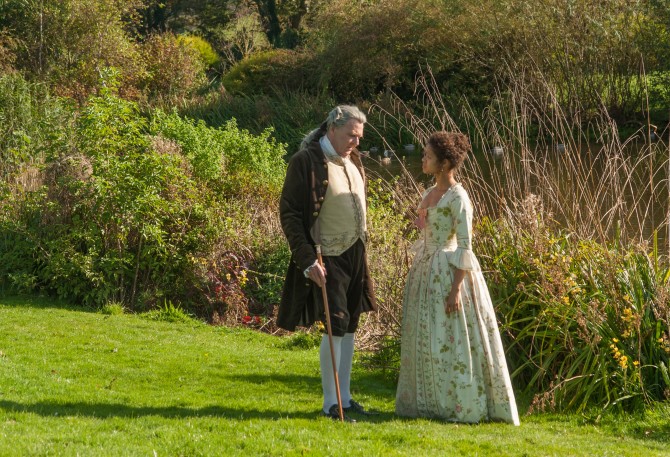Film Review: Belle
By Tola Ositelu
Sometime in 1769 following the death of her mother, young Dido Elizabeth Belle Lindsay (Gugu Mbatha-Raw) – the daughter of an unknown African bondwoman and an aristocratic naval officer – is found by her estranged father, Sir John Lindsay (Matthew Goode), and publicly acknowledged as his own. He leaves her in the care of his childless uncle Lord Chief Justice Mansfield (Tom Wilkinson) and his wife, Lady Mansfield (Emily Watson), both extremely apprehensive about the outside world’s reaction to their newly racially integrated family.
Dido-Belle’s guardians do their best to adjust to the situation but are not entirely successful. She does not receive the same treatment as her lily-skinned, orphaned cousin Lady Elizabeth (Sarah Gadon), occasionally precluded from even dining with the rest of the family. Following her father’s death, Dido inherits an immense fortune, making her financially independent and potentially prime marriage material.

The Mansfields do not believe any amount of money will make their beautiful, sharp-witted grand-niece more acceptable to politesociety, however radical young barrister and Lord Mansfield’s protégé, John Davinier (Sam Reid), is set to prove them wrong. The son of a humble clergy man who knows what it is like to be an outsider amongst the privileged classes, Belle and he are eventually drawn together by their youthful ideals and mutual disgust at the degradation of Africans. Davinier’s lowly origins make him an unsuitable match for Dido in her relatives’ eyes, and they would rather see her married off to tepid aristocrat Lord James Ashford (Alex Jennings), but the young lovers have other ideas. Despite being forbidden from seeing each other by Mansfield, they continueto meet secretly.
Meanwhile the landmark Zong Ship case, on which Chief Justice Mansfield must rule, questions the very legitimacy of the slave trade itself. Dido and John resolve to influence his decision – one that could help set the wheels of great socio-political change in motion.
‘Belle’ has all the delectable corseted dresses, heaving bosoms and hammy-ness one might expect from a drama set in 18thCentury England. Yet despite the archetypal period piece theatrics (and, one suspects, copious liberties taken with the precious few facts in the name of artistic licence), ‘Belle’ is not an exercise in mere frivolity. Little is known of this late 1700s noblewoman of mixed-African heritage living in England at a time when the economy thrived on slavery.
This does not mean that what is known of Dido-Belle should be relegated to dusty historical archives, and the significance of bringing her story to light is in no way diminished by the film’s high entertainment value. That the writer and director, Misan Segay and Amma Asante, are both women of African descent is doubly satisfying. “As a writer and a black woman I was dedicated to finding these stories of other black women in a time when they had little voice” says Segay whose screenplay was inspired by a portrait of Dido-Belle and Lady Elizabeth displayed in Scone Palace, Scotland.
‘Belle’ is a platform from which various social ills are targeted. The film pokes fun at both the repulsion and fetish-like interest Dido attracts from the landed gentry. She duly dispels any doubts about her intellectual prowess or sense of decorum and yet she’s treated like an oddity by all except Davinier. Segay is also keen to point out the parallels between the status of slaves and the so-called society women of the time. The latter were little more than pampered chattel, their worth determined by the personal assets of their husband or whether they married at all.
Mbatha-Raw is impressive in her first major big screen outing, ably rising to the challenge of the title role, assisted by a supporting cast made up of seasoned performers. ‘Belle’ is a refreshingly British venture. There are no token Yanks with dodgy English accents shipped in cynically to win over an
American audience. Veterans Wilkinson and Watson convey sympathetically the struggle of well-meaning adoptive parents, all too often hampered by their own prejudices. Comic relief comes in the form of Miranda Richardson’s devilishly good turn as Dido’s scheming would-be, mother-in-law Lady Ashford, whereas Reid’s Davinier is the embodiment of earnestness. Alas, this depiction of John’s youthful zeal means he is stuck with some of the hammiest lines of all.
‘Belle’ might not be as edgy as some other slavery-related epics that have come to prominence of late. There are no re-enactments of slaves being tortured on plantations or the indignity of the auction block. Nevertheless, it is a compelling account of a moment in history of which most of us would have otherwise been sadly ignorant. Much kudos goes to both Segay and Asante for at long last bringing it to our attention.
[youtube_sc url=”http://www.youtube.com/watch?v=Wtdk6owFj2o”]
‘Belle’ – on release nationwide (UK) from 13 June 2014




I got the feeling that I was watching some polite, British version of what slavery was like under their Empire. In other words, the theme of this movie seemed to be about “let’s talk about slavery, but not really show what it was like”.